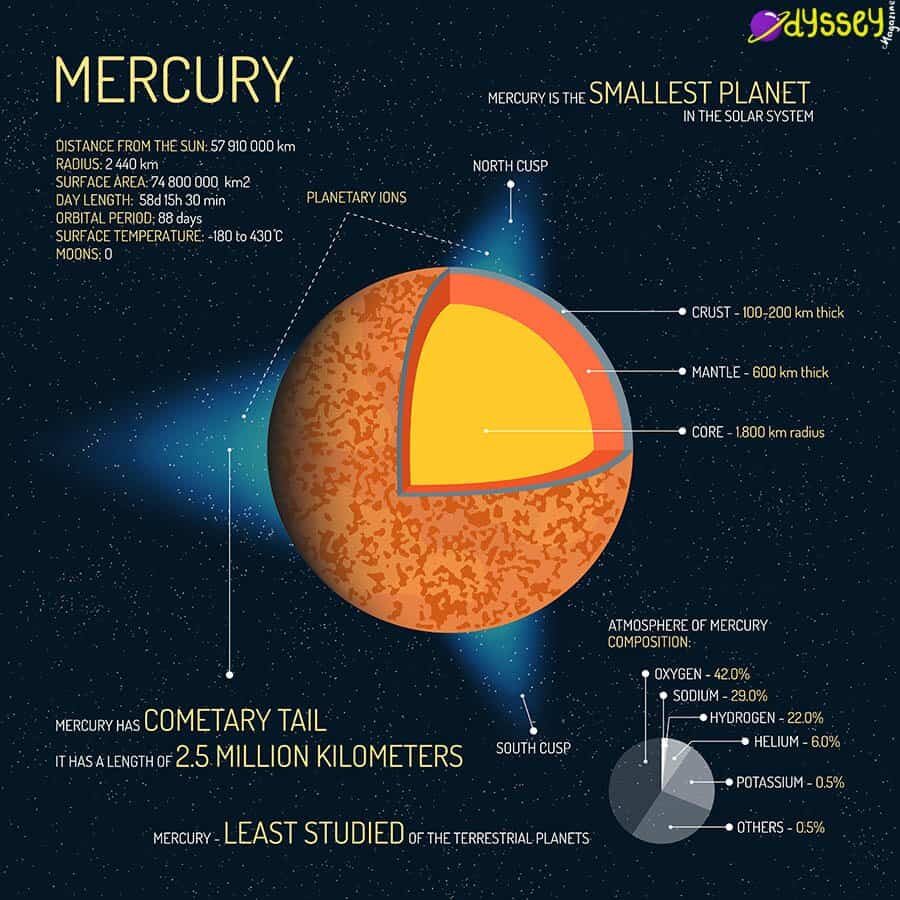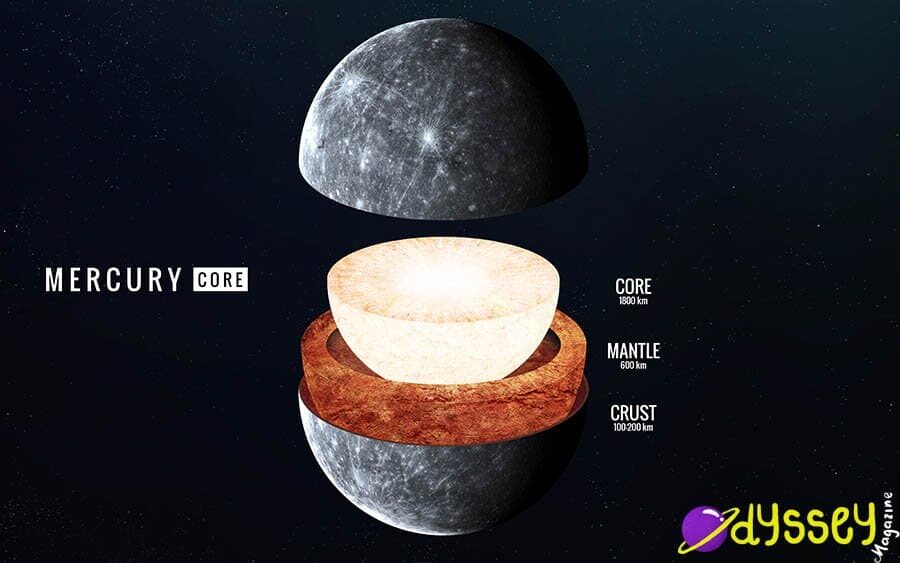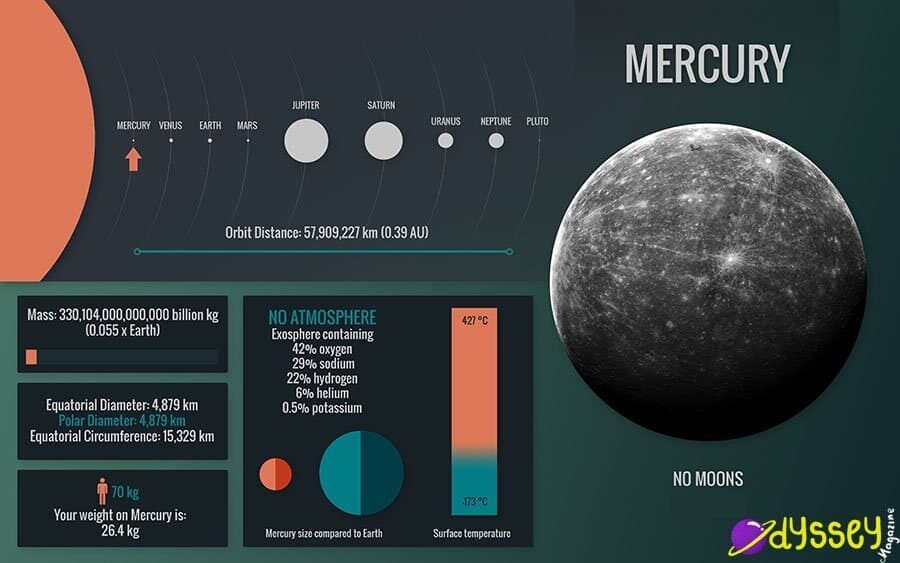23 Mercury Facts | Interesting Facts About the Planet Mercury
The planet Mercury is one of the most interesting parts of our solar system. Our first recordings of Mercury date back a few thousand years, though it’s very likely that humans noticed Mercury from the Earth long before that. There are many facts about Mercury that are good to know, and we’ll take a look at the most fascinating ones in this article.

You probably already know that it’s the closest planet to the Sun. But did you know that even though it’s the closest, it’s not quite as hot as Venus? There are several Mercury facts to know about, and we’ll start with some of the most important ones.
- Mercury is the smallest planet in our solar system.
- Out of all the terrestrial planets (Mercury, Venus, Earth, Mars), we know the least about Mercury.
- It is only about 40% of the size of Earth. There are actually moons of other planets that are bigger than Mercury (Ganymede and Titan)!
- Although people think of Mercury as a red planet, it actually has a dark gray exterior.
- Mercury is an estimated 57910000km away from the Sun.
- It has a radius of 2,440km. Almost 75% of this is made up from its core.
- A full day on Mercury is equal to 59 days on Earth!
- A full year on Mercury is only 88 days long due to its close orbit distance from the Sun. That means that for every one Earth year, this is more than 4 years on Mercury!
- Mercury is the fastest planet to move around the Sun. It does so at a speed of 29 miles per second!
- Mercury has only 38% the surface gravity of Earth. So a 200lb man would only weigh 76lbs on Mercury.
The inner core of Mercury is something that has fascinated astronomers for centuries. Now we know that the core actually makes up the majority of Mercury itself, with it having an 1800km radius. Back in 2007, we thought that more of Mercury’s core was actually molten than solid, due to findings from NASA. However now, we know that the majority of it is actually solid. more like the Earth’s core.

We actually know about Mercury’s core thanks to the MESSENGER spacecraft, which was sent to Mercury in 2011 with the intention to find out about its core. It figured out what Mercury’s core must be made up of based on the way that the planet spun. MESSENGER helped us estimate that about half of Mercury’s entire inner core is solid.
Another aspect of Mercury that is often discussed by astronomers is its atmosphere. In fact, Mercury actually has little to no atmosphere. This is instead replaced by a thin exosphere, made up primarily of oxygen, sodium, hydrogen and helium. This was discovered in 1974 by the Mariner 10 spaceprobe.

If Mercury was to have an atmosphere like Earth, it would actually be much hotter than it is now, as the atmosphere would actually retain heat. The heat from the Sun that hits Mercury effectively goes back into space.
- When Mercury orbits the Sun, it does it in more of an ellipse (oval) shape, rather than a sphere.
- Mercury takes its name from the Roman messenger of the Gods. In Greek mythology, this messenger is known as Hermes. We think it was named this because Mercury was a fast messenger, and Mercury is the fastest planet to orbit the Sun.
- The planet Mercury is actually made up primarily from Iron – it’s estimated that 75-80% of the planet’s core is made from iron, most of which is melted.
- Astronomers thought that Mercury has a melted iron core because when the solar system was formed, the Sun melted its core, leaving only a thin crust exterior. However, we know now Mercury has more of a solid core, like Earth.
- Although temperature on Mercury can exceed 400°, astronomers have still seen frozen ice on it’s surface, as it’s temperature can still be as cold as -180° in some places.
- Despite being closer to the Sun, Mercury actually has a lower surface temperature than Venus. This is because Venus has a greater atmosphere, which keeps the heat contained around the planet – like a greenhouse. This gives it more extreme temperatures than Mercury’s surface.
- Mercury is only one of two planets without a moon – Venus is the other one. Mercury doesn’t have a moon because it’s so close to the Sun, the Sun would probably suck in any moon that was orbiting Mercury.
- Mercury doesn’t have any rings either, because it’s too close to the Sun.
- Albert Einstein’s General Theory of Relativity is still used today to explain how gravity really works – he used Mercury to explain this.
- Like the Moon, Mercury is full of craters. The are more than 410 of them recorded as of 2020.
- Many of these craters are named after writers and artists. The largest crater, Aneirin, is named after a 6th Century Welsh poet. The smallest crater, Angelou, is named after American poet and author Maya Angelou.
- The thin atmosphere that surrounds Mercury’s surface is so thin that’s typically referred to as having no atmosphere at all, just an exosphere.
- It’s thought that the planet Mercury has a molten core, which means that it’s not completely solid as once thought.
As we know Mercury today, there is no (or it is very unlikely to have) any life on the planet. This is because of its closeness to the Sun, which makes the planet inhospitable. However, recently many astronomers have come out and said that they do believe that there once could have been life on Mercury.
Yes, Mercury does have a tail. This is because unlike Venus and Earth, Mercury is too close to the Sun to have an atmosphere permanently, as its gravity isn’t strong enough to maintain it. This causes all the evaporated sodium atoms to be stripped off Mercury, which forms a comet-like tail in the opposite direction of the Sun. This tail extends to longer than 2.5 million kilometers.
Although we don’t know who officially discovered Mercury, the earliest writings we have about the planet date back to Greek astronomer Timocharis back in 265 BC. Little is known about Timocharis, and like many other astronomical findings, we know about this through Ptolemy’s writing The Almagest, written in the 2nd Century.
Mercury is the second hottest planet, and it’s very very close to the Sun. This is far too hot for humans to ever live on Mercury in their current form. In fact, Mars is the most likely planet that humans could live on, and it’s because it’s further away from the Moon! Mars contains many of the things that we humans need, like the possibility to extract water, and a cool enough temperature.
If you’re trying to see Mercury this year, then the best time for you too see it clearly will be towards the end of the year (Sept-Nov). Mercury is easiest to see by looking for the star Spica, which is the brightest star in the Virgo Constellation.
As the closest planet to the Sun, there has always been and will always be a lot of mystery surrounding Mercury. In recent years with space missions, we’ve actually managed to get a lot closer to Mercury than ever before, and we are learning more about this small planet.
These are just some of my favorite Mercury facts, if you have any more to suggest, then please feel free to do so by leaving a comment!





